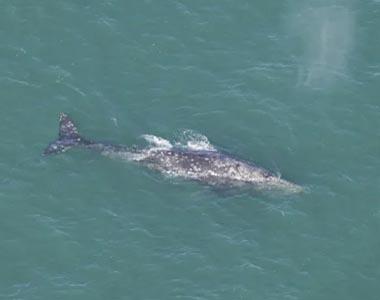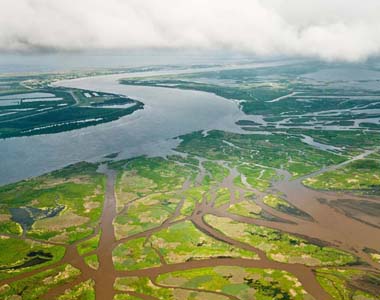 | | | A Pacific whale species was spotted in New England, coastal erosion in California has put clifftop houses in a precarious position, and the largest river in the United States is under constant threat of invasion by a wall of saltwater. Dive into these stories and more in this month’s RCC Coasts and Oceans Observer. Whales, the most iconic and charismatic species emblematic of the awe of the ocean, are widely endangered. In the Gulf of Mexico, the Rice’s whale is on the brink of extinction, with only 50 individuals left in the population. Despite the whales’ critical need for habitat protection, these efforts are undermined by companies that seek to drill for oil and gas in the Gulf.  Human activity also threatens the North Atlantic right whale, of which fewer than 360 remain. To address a leading cause of death in these whales—boat strikes and fishing gear entanglement—the White House Office of Information and Regulatory Affairs is considering a proposal to expand speed limits for boats. Human activity also threatens the North Atlantic right whale, of which fewer than 360 remain. To address a leading cause of death in these whales—boat strikes and fishing gear entanglement—the White House Office of Information and Regulatory Affairs is considering a proposal to expand speed limits for boats.
At the beginning of this month, a whale that went extinct in the Atlantic about 200 years ago was spotted off the coast of Massachusetts. The presence of the gray whale in the Atlantic raises concerns about climate change since the species is only found in the north Pacific. Scientists think the whale made its way to New England through the Northwest Passage in the Arctic Ocean thanks to melting sea ice. If the threats and changes to whale populations are any indication, our oceans are not the same as they once were. Last summer, oceans reached record-breaking temperatures, a trend which is set to continue this year. Scientists warn that this degree of warming may lead to irreversible changes, including ecosystem and ocean current collapse. Climate change has created many challenges for people living on the coast. In California, extreme rainfall has exacerbated coastal erosion, leaving mansions near cliffsides vulnerable, and demonstrating that climate change impacts everyone.  Climate impacts on oceans also threaten our access to freshwater. Last year, a wedge of saltwater from the Gulf of Mexico migrated up the Mississippi River due to drought in the Midwest and subsequent low water levels in the river. This saltwater intrusion event contaminated the tap water of several communities in southeastern Louisiana. While the contamination largely subsided at the beginning of this year, researchers and residents continue to grapple with the looming threat of the saltwater wedge. Climate impacts on oceans also threaten our access to freshwater. Last year, a wedge of saltwater from the Gulf of Mexico migrated up the Mississippi River due to drought in the Midwest and subsequent low water levels in the river. This saltwater intrusion event contaminated the tap water of several communities in southeastern Louisiana. While the contamination largely subsided at the beginning of this year, researchers and residents continue to grapple with the looming threat of the saltwater wedge.
In the face of climate change, organizations like the North Carolina Living Shorelines Academy are pursuing innovative adaptation strategies. The Living Shorelines Academy is offering a course in living shoreline construction and permitting at a community college in coastal North Carolina with the goal of making small-scale living shorelines more accessible for homeowners.  Young people are calling attention to ocean and climate issues through art. An article from oceanographic displays works from the Bow Seat Ocean Awareness Contest, which encourages youth “artivists” (artist activists) to explore topics like sea level rise, plastic pollution, and species protection. Young people are calling attention to ocean and climate issues through art. An article from oceanographic displays works from the Bow Seat Ocean Awareness Contest, which encourages youth “artivists” (artist activists) to explore topics like sea level rise, plastic pollution, and species protection.
And, young authors continue to make their mark and reveal their love for the majesty of the oceans. Hannah Stowe’s Move Like Water: My Story of the Sea (Tin House, 2023) is just the latest example of the pull and power of the sea.
This March issue of the RCC Observer shows well that even as the ocean is under assault, it has dedicated champions and activists, as well as the indomitable spirit of people who, in the face of unprecedented challenges, have proposed and produced some inspiring solutions. | | | | | | | |  Emma Brentjens - RCC National Environment Leadership Fellow (Presidential) Emma Brentjens - RCC National Environment Leadership Fellow (Presidential)
Emma Brentjens is the co-lead of the RCC Coasts and Oceans program. She is a Master of Environmental Management student at Duke University studying Ecosystem Science and Conservation and Community-based Environmental Management. | | | | | | Scientists Fear Planetary Shift as Record Ocean Heat Enters Second Year Warming trend could represent a major change to Earth systems that cannot be reversed on any human time scale. At this time last year, scientists watched in disbelief as the world’s oceans surged to record levels of warmth and wondered what could have triggered it. The jump in sea surface temperatures was more dramatic than anything seen before. | | | | | | | | The Oceans We Knew Are Already Gone As far as humanity is concerned, the transformation of our seas is “effectively permanent.” Even after nearly three months of winter, the oceans of the Northern Hemisphere are disturbingly warm. Last summer’s unprecedented temperatures—remember the “hot tub” waters off the coast of Florida?—have simmered down to a sea-surface average around 68 degrees Fahrenheit in the North Atlantic, but even that is unprecedented for this time of year. | | | | | | | | Can We Save the Mississippi? The coastal United States has faced increasing threats due to climate change, with sea level rise, intense storms, and flooding battering the coastline. Louisiana is on the frontline of these threats. Since the 1930s, the state has lost almost 2,000 square miles of land. Some areas on the state’s coast are already grappling with the question of continuing to restore the land or retreat to avoid greater risks. Now, the impacts of sea level rise have reached freshwater systems as a mass of saltwater from the Gulf of Mexico travels up the Mississippi River. | | | | | | | | On the Brink: California’s Luxe Clifftop Mansions in Peril After Record Rain Homeowners in wealthy towns watching anxiously in face of heavy storms that have caused flash floods and coastal erosion The torrents of water coming from the sky are having ripple effects on the cliffs that hold up some of California’s most expensive real estate. In the first two months of the year, nearly 18in of rain has fallen in the southern California area, about 8in above normal to date – and more is on the way this week. | | | | | | | | New Lake Will Fuel Petrochemical Expansion on Texas Coast Blocked in Louisiana, Formosa Plastics looks to grow around Lavaca Bay instead. But it and other interested industrial plants are waiting for more water. Texas regulators last month approved water rights for a new, 2,500-acre reservoir to meet the growing needs of chemical plants, refineries and other industries on the Gulf Coast. | | | | | | | | Academy Aims to Make Living Shorelines More Accessible A team of educators and scientists is combining efforts to build a program that makes small-scale living shorelines a practical option for waterfront property owners. The N.C. Living Shoreline Academy held its first introductory course last fall at Carteret Community College in Morehead City and is getting ready to offer it again, along with the new structure and design course. | | | | | | | | Inconvenient Truths About an Inconvenient Whale (Opinion) Getting out on the water is a way of life in Texas’ coastal cities and towns. A rare few folks experience the incredible sight of a shark’s dorsal fin breaking the water or a stingray dramatically breaching. And just a handful have witnessed a majestic whale on the water’s surface and fewer still a Rice’s whale. It’s a memory that might die with our generation because the survival of Rice’s whales, the only baleen species native to the Gulf, is in grave doubt. | | | | | | | | Climate Change and Boat Strikes Are Killing Right Whales. Stronger Speed Limits Could Save Them. Nearly a century after we almost hunted them to extinction, fewer than 360 right whales remain. Earlier this month, a proposal to expand speed limits for boats — one of the leading causes of death for the endangered whales — took a key step forward: It’s now under review by the White House Office of Information and Regulatory Affairs, the last stage of federal review. | | | | | | | | What Is a Whale Native To the North Pacific Doing Off New England? Climate Change Could Be the Key Scientists have confirmed the presence of a whale off New England that went extinct in the Atlantic Ocean two centuries ago — an exciting discovery, but one they said that illustrates the impact of climate change on sea life. Researchers with the New England Aquarium in Boston found the gray whale while flying 30 miles south of Nantucket, Massachusetts, on March 1. | | | | | | | | | | Georgia Could Greenlight a Mine Near One of the South’s Last Wild Places A planned titanium mine near the edge of the Okefenokee National Wildlife Refuge has drawn fierce resistance from people worried about the fate of the largest intact blackwater swamp in North America. Charlene Carter’s family has spent generations in and around the Okefenokee Swamp. Its tannin-stained waters are practically part of her blood; its hundreds of bird species her eternal soundtrack; its maze of narrow canals, haunting cypress trees and ever-present alligators the backdrop of so many memories. | | | | | | | | Harnessing Creativity In a world inundated with information, reaching and engaging diverse audiences on critical issues like ocean health requires innovative approaches. One powerful avenue is artivism, a fusion of art and activism that transcends traditional communication barriers. Artivism becomes a transformative force, especially when nurturing the environmental consciousness of the next generation. As the alarming realities of climate change, pollution, and biodiversity loss loom, empowering youth to be advocates for ocean resilience is paramount. | | | | | | | | Move Like Water
My Story of the Sea by Hannah Stowe  “A sensuous book, more felt than described, more described than explained, more painted than penned: part memoir, part journal and. . . . part natural mystery tour.”—Carl Safina, The New York Times Book Review “A sensuous book, more felt than described, more described than explained, more painted than penned: part memoir, part journal and. . . . part natural mystery tour.”—Carl Safina, The New York Times Book Review
A book to sweep you away from the shore, into a wild world of water, whale, storm, and starlight— to experience what it’s like to sail for weeks at a time with life set to a new rhythm.
As a young girl, Hannah Stowe was raised at the tide’s edge on the Pembrokeshire coast of Wales, falling asleep to the sweep of the lighthouse beam. Now in her midtwenties, working as a marine biologist and sailor, Stowe draws on her professional experiences sailing tens of thousands of miles in the North Sea, North Atlantic, Mediterranean, Celtic Sea, and the Caribbean to explore the human relationship with wild waters. Why is it, she asks, that she and so many others have been drawn to life at sea—and what might the water around us be able to teach us?  Braiding her powerful and deeply personal narrative and illustrations with stories of six keystone marine creatures—the fire crow, sperm whale, wandering albatross, humpback whale, shearwater, and the barnacle—Stowe invites readers to fall in love, as she has, with the sea and those that call it home, and to discover the majesty, wonder, and vulnerability of the underwater world. Braiding her powerful and deeply personal narrative and illustrations with stories of six keystone marine creatures—the fire crow, sperm whale, wandering albatross, humpback whale, shearwater, and the barnacle—Stowe invites readers to fall in love, as she has, with the sea and those that call it home, and to discover the majesty, wonder, and vulnerability of the underwater world.
For fans of Rachel Carson and Annie Dillard, Move Like Water: My Story of the Sea is an inspiring, heartfelt hymn to the sea, a testament to finding and following a dream, and an unforgettable introduction to a deeply gifted nature writer of a new generation. Click here to read more and purchase | | | | | |  The Rachel Carson Council Depends on Tax-deductible Gifts From Concerned Individuals Like You. Please Help If You Can. The Rachel Carson Council Depends on Tax-deductible Gifts From Concerned Individuals Like You. Please Help If You Can. | | | | | | | |  Sign Up Here to Receive the RCC E-News and Other RCC Newsletters, Information and Alerts. Sign Up Here to Receive the RCC E-News and Other RCC Newsletters, Information and Alerts. | | | | | | | | | | | |